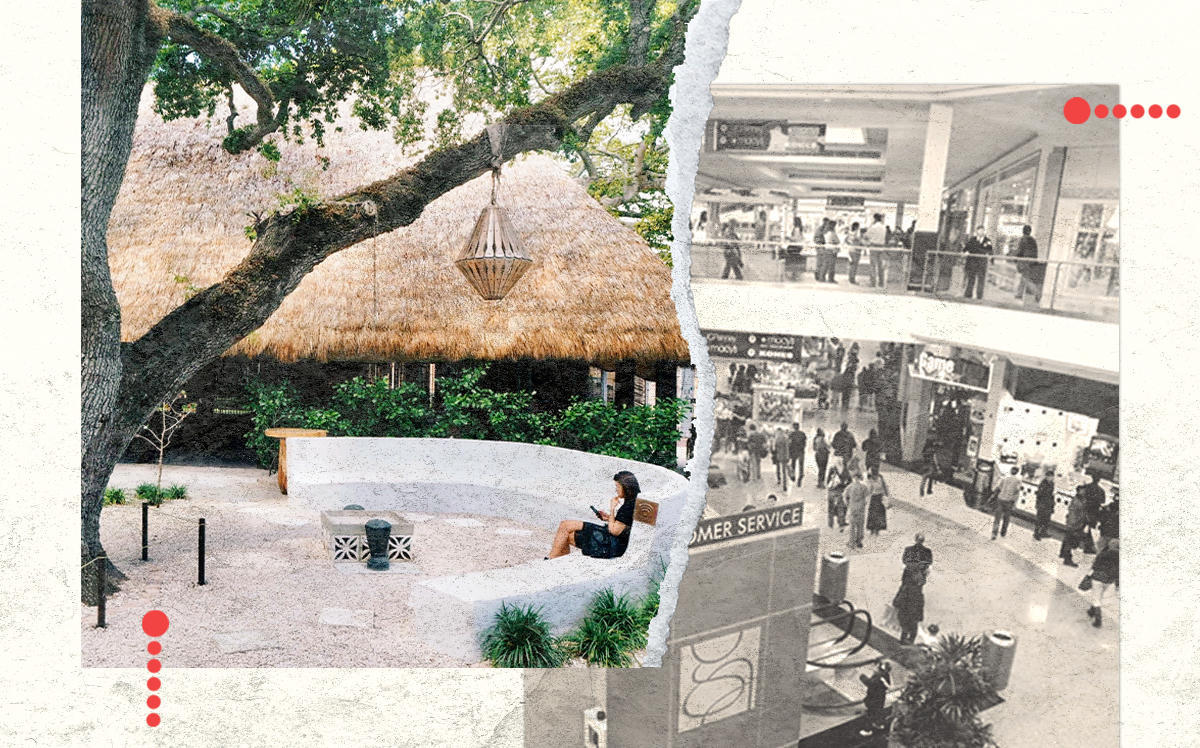Trending
Open air windfalls: Shopping centers breeze past malls in their recovery
More investors are betting on shopping centers and outlet stores as the pandemic rages on, but will shifting consumer habits have the final say?

Since reopening in May, Miami’s Upper Buena Vista has seen its foot traffic surpass normal pre-Covid levels, according to the shopping center. And the mixed-use “pocket-village” with 21 stores, 12 of which have opened during the pandemic and five more that are slated to open soon, is now back to almost full occupancy.
The increase in business for the 60,000-square-foot open air mall, which was built around two large centenary trees, is impressive during a regular year, let alone one plagued by retail bankruptcies and store closures.
“We’ve really just adapted the space to whatever is needed by the community,” said Katherin Schultz, Upper Buena Vista’s marketing director.
Outdoor shopping centers, or strip malls, and outlets made up of individual manufacturer stores have been outpacing enclosed malls in their recovery.
Both are in a better position when it comes to the kinds of tenants and customers they attract as people flock to open air spaces while they shop for essential goods like home and office supplies. At the same time, in-store apparel shoppers (a shrinking demographic among consumers) are largely gravitating to bargain deals found in outlets, leaving luxury stores in enclosed malls with even fewer customers.
As a result, shopping center and outlet mall owners like RPT Realty and Tanger Factory Outlet Centers — two of the biggest players with combined market caps of nearly $1 billion — have been reaping much of what’s left of investor interest in retail, according to industry sources.
“In March and April, there was a major sell off across the board,” said Kevin Brown, an equity analyst at Morningstar who covers real estate investment trusts. “Malls took a bigger hit [to their share price], a decline of 60 to 70 percent, whereas shopping centers took a 40 to 50 percent hit.”
The two sectors have seen their overall stock values improve relatively consistently since then, with shopping centers remaining in the lead, according to Brown.
And the shift towards outdoor spaces may be consequential in the coming fourth quarter and beyond — as property owners lay the foundations for upgrades, future acquisitions and ground-up developments.
“Safety is now first and foremost in almost every shopper’s mind,” said Greg Maloney, who oversees JLL’s retail brokerage business in the Americas. “There’s no way I can convince people that you’re going to be safer in an enclosed mall than you are walking down the street.”
“That perception is too strong right now,” he noted.
Winners and losers
RPT Realty, which owns and operates nearly 50 open air shopping centers across the country, had collected 86 percent of its rent from tenants, as of September, while deferrals made up just 7 percent of the total, according to its latest earnings report.
Even in the second quarter, the New York-based company reported that it collected 70 percent of rent — averaging far above mall REITs. Macerich, by comparison, saw its rent collections drop to as low as 26 percent in April, while Simon Property Group was at 51 percent in April and May and 69 percent in June. Neither Macerich or Simon Property have reported third quarter earnings yet.
Before Covid-19, “the whole world was believing in experiential,” RPT Realty’s president and CEO Brian Harper told The Real Deal. “Now it’s shifted to essential. Real estate is a supply and demand business.”
While malls have suffocated under the weight of apparel stores — which have lost countless shoppers to the internet since March — strip malls benefit from a more essential tenant mix.
By mid-September, apparel stores had paid just 65 percent of rent for the month, while supermarkets, which anchor the majority of open air centers, paid 93 percent of rent, according to a report by Datex Property Solutions. Other retail tenants that have seen an overall boost during the pandemic also did well, including drug stores, at 98 percent, office supplies stories, at 97 percent, and home improvement retailers, at 93 percent.
Safety is now first and foremost in almost every shopper’s mind. — Greg Maloney, JLL
Department stores, meanwhile, have faced more than two dozen bankruptcies this year and even more voluntary closures, despite making 88 percent of their rent payments overall, per Datex.
Macy’s has moved away from mall locations to open smaller stores in open air shopping centers. Gap, similarly, is exiting all of its mall spaces, a move that will result in the closure of 350 stores across its brands.
For open air shopping centers, “occupancy rates have generally held up,” said Michael Gorman, a REIT analyst and managing director of research at financial services firm BTIG.
Power outlets
Outlets have found their own success during the pandemic.
Simon Property Group, which operates nearly 70 outlets in addition to its 106 malls, reported that its outlet stores were operating at 90 percent compared to prior-year levels.
Tanger Outlets, one of the largest outlet operators in the country, similarly outpaced its own estimates. In a second quarter earnings call, the company said it expected to collect just 43 percent of rents billed and defer 26 percent at its 39 shopping centers.
By July 31, however, the North Carolina-based REIT had collected 72 percent of rents billed for the month, totalling $62 million for the quarter, while deferring $31 million. Tanger Outlets has 30 new stores and 35 pop ups opening across its portfolio this year, according to its earnings call.
“We’ve got a lot of new progress going, and a lot of leasing happening, not only for this year but also for next year,” Stephen Yalof, the company’s president and COO, said during the call.
Of course, some outlet retailers like Ascena — which owns Ann Taylor and Lane Bryant — have suffered bankruptcies. But David Hinkle, a principal of the Outlet Resource Group, an operator and consultancy firm, said that bankruptcies have been a far greater problem for indoor malls, which are anchored by many of the bankrupt retailers.
Store closures often involve smaller spaces in outlets, which allows flexibility for new leasing, Hinkle maintained. The six outlets that his company operates across the country, for example, have seen new leasing largely with local businesses.
“From an ownership standpoint, I’d much rather have that to deal with than to have an enclosed mall with a J.C. Penney, a Sears and two other department stores, all of which are at risk right now,” Hinkle said.
“At the end of the day, a retailer wants to go where the traffic is,” he added, noting that stores like Nike have been doing well amid the pandemic, in part thanks to their outlets.
Mall over?
But while indoor mall recovery has been slow, some say it’s still too early to bet against the entire sector.
Malls typically bring in more residents from further away than other retail locations. Nearly 20 percent of shoppers come to spend a full day at the mall, according to May 2018 research by eMarketer.
“It’s not just looking at foot traffic … you also have to think about the duration of the visits,” said Scott Hessell, director of the Terry J. Lundgren Center for Retailing at the University of Arizona. “Indoor malls tend to [attract] longer visits, because there’s usually more things to do.”
The fall and winter are also peak seasons for malls and some hope that the holidays, along with the cold weather in many states, will spark a return among shoppers. Although many are shifting to e-commerce and local retailers, about 45 percent of shoppers still plan to visit malls to do some or all of their holiday buying, according to a recent report by the International Council of Shopping Centers.
“The bottom line is when people want to go shopping, and they want to be out and they want to have an experience,” JLL’s Maloney said. “They’re still going to go to their brick and mortar location.”
But with traditions like Black Friday being cancelled by some retailers and mall operators, as Covid resurges in many states and brick-and-mortar retailers continue to grapple with the pandemic, that could change.
“Black Friday is going to be completely different,” said Shelley Kohan, an adjunct professor of retail at the Martin J. Whitman School of Management at Syracuse University. “I’m calling it Gray Friday.”
Retailers are also facing inventory issues — from an oversupply of summer merchandise to shortages in winter stock due to delayed shipping times and supply chain disruptions. That could also give outlets the upper hand as inventory is moved to be sold at a discount.
All things considered, though, many investors moved their money away from retail altogether in the first few months of the pandemic. That will remain a challenge for owners and operators moving forward, no matter the sector, according to analysts.
“There’s still just a lot of uncertainty around all aspects of retail at the moment,” BTIG’s Gorman said. “It’s just very hard for investors to get their arms around what cash flow is going to look like in 2021.”




